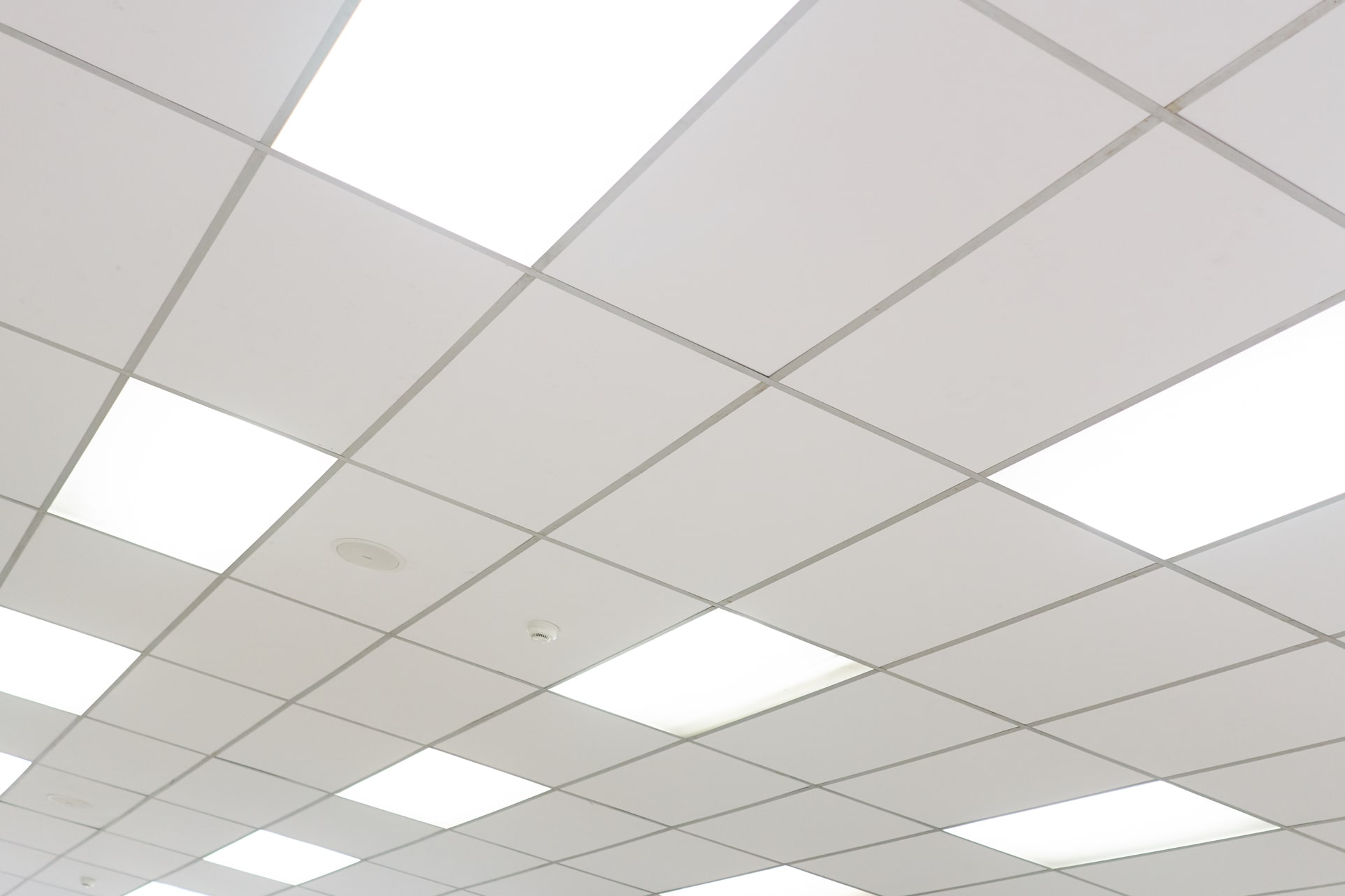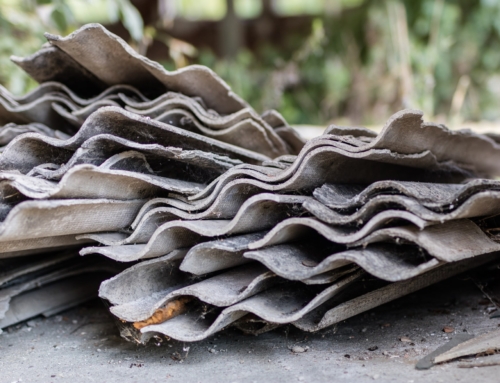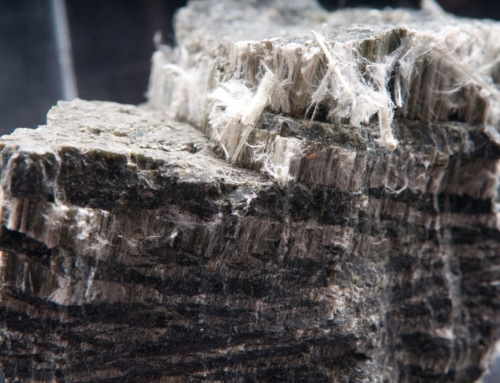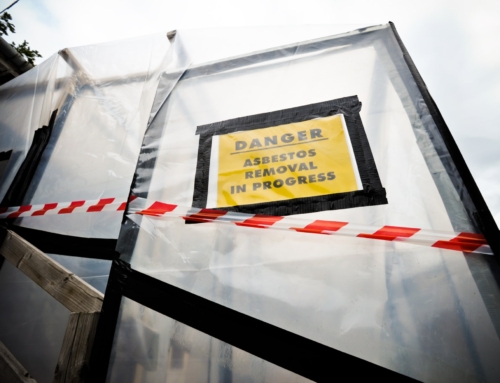With concerns about crumbling concrete and asbestos exposure in many UK buildings, there’s a renewed spotlight on dangerous materials located within properties.
Ceiling tiles are a common feature in many places like hospitals, offices and schools, coming in various materials. In the past, asbestos was often used in the manufacturing of ceiling tiles, so it’s vital we increase awareness of the dangers to keep building occupants safe.
Here’s our easy guide to identifying asbestos ceiling tiles.

What are the different types of asbestos ceilings?
The two most common types of asbestos ceilings are sprayed-on and drop-in tiles.
Asbestos-containing drop-in tiles are square or rectangular, placed in a grid system on the ceiling. They can have a smooth or textured surface and are commonly found in places like office buildings and schools.
By contrast, sprayed-on ceilings consist of a mixture of asbestos fibres, binders and water, creating a popcorn-like texture. Spraying of asbestos was banned in the UK in 1986, and the supply of certain textured paints and plasters in 1988.
What are Artex ceilings?
Artex ceilings were used as a decorative ceiling finish before asbestos was banned in the UK. Instead of flat or smooth plaster, the raised textures would be in a pattern, like swirls, peaks or fan shapes.
Unfortunately, many Artex ceilings contained small amounts of asbestos (usually white chrysotile) to make the coatings stronger and crack-resistant. The concern is that if this type of ceiling is sanded, drilled or removed, harmful asbestos fibres could be released into the air.
How common are asbestos ceiling tiles in the UK?
Asbestos-containing materials (ACMs) were commonly used between the 1950s and 80s, with all types banned by 1999 in the UK. Many older properties still contain asbestos materials, with it estimated that 1.5 million buildings remain affected.
If your ceiling tiles (especially older acoustic/suspended ones) or ceiling boards (AIB) were installed during this time period, they could well contain asbestos. Asbestos was slowly being phased out in the 1980s and 1990s, but older warehouse stock may have been used.
Buildings built after 1999 have a low likelihood of asbestos ceilings being present if the law was followed.
Where are asbestos ceiling tiles found?
Asbestos ceiling tiles were widely used in various settings, including residential, commercial, and industrial buildings. This was thanks to several benefits, primarily because of its fire-resistant, heat-resistant and sound-insulating properties.
Common places where you might find asbestos ceiling tiles include older homes built before the mid-1980s, in areas like basements, bathrooms and utility rooms. Offices, schools, warehouses, hospitals, kitchens and commercial buildings are also a common hotspot.
At Goodbye Asbestos, we also get a lot of calls to remove asbestos from 1960s and 1970s houses.
How do you know if ceiling tiles have asbestos in them?
Unfortunately, identifying asbestos-containing ceiling tiles can be challenging, as they often look similar to non-asbestos tiles. The most reliable method is to hire a certified asbestos inspector to collect samples and conduct asbestos testing. They will use appropriate safety measures to take samples and send them to a laboratory for analysis.
The age of the building can give you clues, as many industries had stopped using asbestos ceiling tiles by 1989, although asbestos wasn’t fully banned in the UK until 1999. You should also review any available records or building plans to see if asbestos materials were specified or installed during construction.
What do asbestos ceilings look like?
Key features of asbestos-containing ceilings include textured surfaces, with common patterns including stippling, popcorn or a cottage cheese appearance. These textures were achieved by mixing asbestos fibres into the material.
Asbestos ceiling tiles are often white, grey, or off-white, although the colour alone is not a definitive indicator of asbestos content. They can also have a distinctive scalloped or squared-edge design.
However, it’s important to remember that visual inspections alone are not conclusive, so professional testing is often necessary to confirm the presence of asbestos in ceiling tiles.
What are the risks of removing asbestos ceiling tiles?
Never attempt to remove any type of asbestos ceiling yourself. Even a small amount of damage or disturbance (like drilling or sanding) can release the harmful fibres. These tiny fibres could get inside the lungs and cause health issues like lung cancer, mesothelioma and asbestosis, even years down the line after initial exposure.
Because of the dangers, asbestos ceiling removal should only be performed by qualified contractors who know how to handle and dispose of the materials safely. If you think you have an asbestos ceiling, call an expert to complete a survey.
Signs you need your asbestos ceiling removed include cracked tiles, spalling and flaking, crumbling and water damage.
How much to remove an asbestos ceiling?
The cost to remove an asbestos ceiling in the UK can vary a lot, depending on the type of asbestos material. For example, some friable materials and insulating boards require much more care, containment and licensing, increasing the costs. There are also higher risks associated with deteriorated ceiling coatings and asbestos board.
An asbestos ceiling removal contractor will also factor in the size of the ceiling. The larger the ceiling, the more labour, safety setup and asbestos waste to consider. Higher asbestos ceilings, awkward shapes and scaffolding can also require more expertise.
What to do if you have asbestos ceiling tiles – the next steps
If you have asbestos ceiling tiles, contact an expert. They’ll come out to assess your ceiling and talk you through the benefits of encapsulation vs removal vs leaving the material undisturbed.
If you’re a business or landlord, you are legally responsible for the health and safety of your staff and tenants. Asbestos must continually be monitored and managed appropriately.
Do you need asbestos ceiling tile testing? Contact us today
Goodbye Asbestos works across London, Surrey and the Home Counties, offering expert asbestos testing, surveys and removals in Fareham, Farnborough and beyond. We always use UKAS-accredited laboratories for reliable results.
For expert advice or a free quote, contact us.




